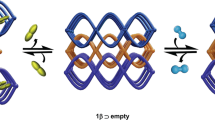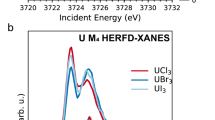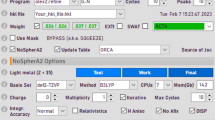Abstract
WE have measured G values for the decomposition of a number of anhydrous nitrates by X-rays of 44.5 kVp. from a beryllium-windowed tube. The decomposition proceeds almost entirely according to the overall reaction:  In Fig. 1, G values for the initial rate of decomposition are plotted against ‘free space’ per nitrate ion in the crystals. The ‘free space’ is the difference between the volume of the crystal and the volume of the ions in it, taking the volume of the nitrate ion somewhat arbitrarily as 14.5 A.3. (This is the total volume of its three oxygen atoms1.)
In Fig. 1, G values for the initial rate of decomposition are plotted against ‘free space’ per nitrate ion in the crystals. The ‘free space’ is the difference between the volume of the crystal and the volume of the ions in it, taking the volume of the nitrate ion somewhat arbitrarily as 14.5 A.3. (This is the total volume of its three oxygen atoms1.)
This is a preview of subscription content, access via your institution
Access options
Subscribe to this journal
Receive 51 print issues and online access
$199.00 per year
only $3.90 per issue
Buy this article
- Purchase on SpringerLink
- Instant access to full article PDF
Prices may be subject to local taxes which are calculated during checkout
Similar content being viewed by others
References
Zachariasen, W. H., J. Amer. Chem. Soc., 53, 2123 (1951).
Hennig, G., Lees, R., and Matheson, M. S., J. Chem. Phys., 21, 664 (1953).
Author information
Authors and Affiliations
Rights and permissions
About this article
Cite this article
CUNNINGHAM, J., HEAL, H. Effect of ‘Free Space’ in the Decomposition of Solid Nitrates by X-rays. Nature 179, 1021–1022 (1957). https://doi.org/10.1038/1791021a0
Issue date:
DOI: https://doi.org/10.1038/1791021a0
This article is cited by
-
Exciton decomposition of compounds with ionic bonds
Soviet Physics Journal (1967)



